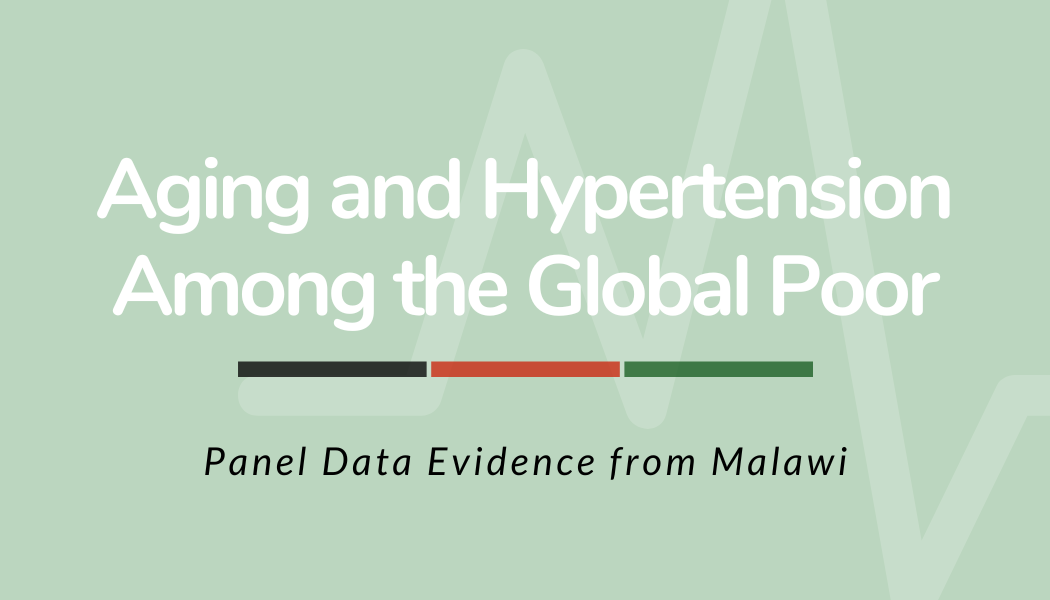
Commons Link
Aging and Hypertension among the Global Poor—Panel Data Evidence from Malawi
Working Paper Number
2022-82
Publication Year
2022
Paper Abstract
Background: Hypertension has a rapidly growing disease burden among older persons in low-income countries (LICs) that is often inadequately diagnosed and treated. Yet, most LIC research on hypertension is based on cross-sectional data that does not allow inferences about the onset or persistence of hypertension, its correlates, and changes in hypertension as individuals become older.
Data and methods: The Mature Adults Cohort of the Malawi Longitudinal Study of Families and Health (MLSFH-MAC) is used to provide among the first panel analyses of hypertension for older individuals in a sub-Saharan LIC using blood pressure measurements obtained in 2013 and 2017.
Findings: High blood pressure is very common among mature adults aged 45+ in rural Malawi, and hypertension is more prevalent among older as compared to middle-aged respondents. Yet, in panel analyses for 2013-17, we find no increase in the prevalence of hypertension as individuals become older. Hypertension often persists over time, and the onset of hypertension is predicted by factors such as being overweight/obese, or being in poor physical health. Otherwise, however, hypertension has few socioeconomic predictors. There is also no gender differences in the level, onset or persistence in hypertension. While hypertension is associated with several negative health or socioeconomic consequences in longitudinal analyses, cascade-of-care analyses document significant gaps in the diagnosis and treatment of hypertension.
Conclusions: Our findings indicate that hypertension and related high cardiovascular risks are widespread, persistent, and often not diagnosed or treated in this rural sub-Saharan population of older individuals. Prevalence, onset and persistence of hypertension are common across all subgroups-including, importantly, both women and men. While age is an important predictor of hypertension risk, even in middle ages 45-55 years, hypertension is already widespread. Hypertension among adults aged 45+ in Malawi is thus more similar to a "generalized epidemic" than in high-income countries where cardiovascular risk has strong socioeconomic gradients and untreated hypertension particularly prevalent in vulnerable subsets of older persons.
Data and methods: The Mature Adults Cohort of the Malawi Longitudinal Study of Families and Health (MLSFH-MAC) is used to provide among the first panel analyses of hypertension for older individuals in a sub-Saharan LIC using blood pressure measurements obtained in 2013 and 2017.
Findings: High blood pressure is very common among mature adults aged 45+ in rural Malawi, and hypertension is more prevalent among older as compared to middle-aged respondents. Yet, in panel analyses for 2013-17, we find no increase in the prevalence of hypertension as individuals become older. Hypertension often persists over time, and the onset of hypertension is predicted by factors such as being overweight/obese, or being in poor physical health. Otherwise, however, hypertension has few socioeconomic predictors. There is also no gender differences in the level, onset or persistence in hypertension. While hypertension is associated with several negative health or socioeconomic consequences in longitudinal analyses, cascade-of-care analyses document significant gaps in the diagnosis and treatment of hypertension.
Conclusions: Our findings indicate that hypertension and related high cardiovascular risks are widespread, persistent, and often not diagnosed or treated in this rural sub-Saharan population of older individuals. Prevalence, onset and persistence of hypertension are common across all subgroups-including, importantly, both women and men. While age is an important predictor of hypertension risk, even in middle ages 45-55 years, hypertension is already widespread. Hypertension among adults aged 45+ in Malawi is thus more similar to a "generalized epidemic" than in high-income countries where cardiovascular risk has strong socioeconomic gradients and untreated hypertension particularly prevalent in vulnerable subsets of older persons.